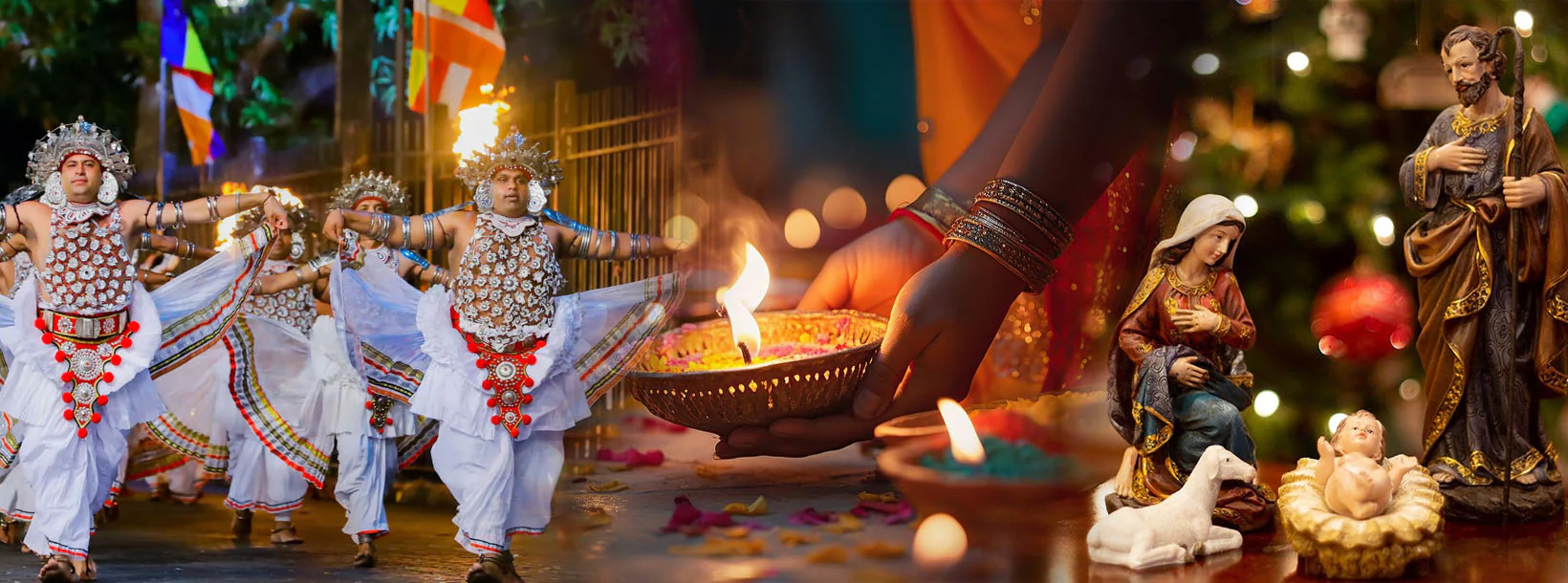
Religious Events
Religious events in Sri Lanka reflect its rich cultural tapestry, with festivals celebrated by Buddhists, Hindus, Christians, and Muslims. Key events include the Buddhist Vesak, Hindu Thai Pongal, Christian Easter, and Muslim Ramadan. These celebrations feature vibrant rituals, processions, and community gatherings, offering a unique glimpse into Sri Lanka's spiritual heritage and its harmonious blend of diverse traditions.
Duruthu Perahera
Marking the beginning of Sri Lanka’s Buddhist Calendar, the Duruthu Perahera is one of the most culturally glorious processions celebrated by devotees annually during the month of January (Duruthu). The main festivities are organized at the historic Kelaniya Rajamaha Viharaya (Temple) annually during the pre-full moon poya day in January to mark the first visit of Lord Buddha to Sri Lanka. Dating back to the year 1927, this grand assemblage is witnessed and celebrated by devotees who arrive in Kelaniya from all parts of the country not failing to attract tourists who are left in awe with the festivities carried out during this auspicious time period. The traditions and culture of the grand heritage of Sri Lanka is depicted throughout the procession which is considered the highlight of many rituals and ceremonies preceding the event. The entire festival consists of three stages while it commences with a series of religious sermons held each night which leads up to the festivities.That is followed by a week of Pirith Ceremonies and finally ending all celebratory proceedings with the Perahera which is held during three consecutive nights.
The “Udamaluwa Perahera” which is the first day procession is held in the upper terrace area of the Kelaniya Temple. Here the Dathu Perahera is conducted in a small scale with only a few elephants, whip crackers, fire dancers, flag bearers, dancers and drummers. The “Pahatha Maluwa Perahera” which is the second day procession is more colourful and elaborate than the first with the Dathu Perahera leading and the three Devala Peraheras trailing behind. The “Randholi Perahera” which is the third and final procession of the Duruthu Maha Perahera is a magnificent spectacle of colour, tradition, grandeur and religious fervour. Many of the devotees who gather in the temple premises join in the celebrations by chanting on the roadsides.
The Perahera is headed by whip-crackers who herald the approach of the procession. Then comes the fire-ball performers, followed by a large number of elephants and tuskers carrying the sacred relic casket and dressed in shiny attire, flag bearers, drummers, dancers, Buddhist monks, chief incumbents of the temple, attendants and village folk who have strived to make the festivities a success. The entire length of the procession is illuminated by torches and decorated with colourful banners and flags that displays religious insignia relevant to each temple and devalas which are associated with the Duruthu Perahera. The procession returns to the temple, after travelling the entire length of the marked route while a cannon booms to indicate the closing ceremony of this grand pageant.
The Kelaniya Temple carries many legends around it and it is also a resplendent representation of Buddhist architecture and art of ancient Sri Lanka that attracts many tourists local and foreign on a regular basis. The first entrance consists of the “Makara Thorana” (a mythological creature carved in to an archway) which is a symbol of protection. The carved “Makara” is an interesting combination of many creatures which has to be witnessed with ones own eyes. A main shrine area, dagoba, moonstone, the reclining Buddha statue, the sacred Bo tree and many more statues of the Lord Buddha in various positions are found within the premises of the temple. Due the location of the Kelaniya Temple adjoining the “Kelaniya River” and its close proximity to Colombo, visitors are drawn to explore this magnificent structure with its carvings, frescos, statues and grandeur of a proud heritage.
















